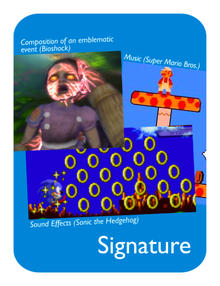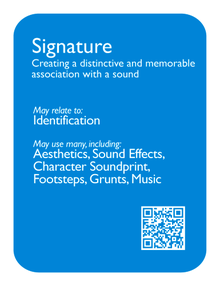Signature

|

| |
| The card's front face | The card's back face |
Contents
Synopsis
| Creating a distinctive and memorable association with a sound. |
Relationships
May relate to:
Identification ![]() .
.
May use many, including:
Aesthetics ![]() , Sound Effects
, Sound Effects ![]() , Character Soundprint
, Character Soundprint ![]() , Footsteps
, Footsteps ![]() , Grunts
, Grunts ![]() , Music
, Music ![]() .
.
Description
Sound is prevalent in many of the most recognized Signatures in games. A Signature supports a strong link between players and on what they keep in memory from their experience while playing. Not only, it evokes a memory but it also works as a token that allows different players to communicate their common experience.
Building a Signature is both relevant in emotional and commercial terms.
A Signature is, almost by definition, achieved through singularity. Music or particular Sound Effects are common ways to achieve it, but aspects of the Characters' Soundprint also constitute a vast space of opportunities.
Examples
  Sonic the Hedgehog: This is one of the patterns included in our seminal collection [1] but it was presented with another name: “Entrainment”. Meanwhile we realized three things:
• In this pattern, entrainment is the “means”, not the solution. Considering that the name of a pattern should reflect the solution (not the means), “Entrainment” was not adequate name.
• We are not aware of any explicit reference to the iteration of phases this pattern addresses, so we don’t know of a name that is already used to express it. Consequently we had to define it ourselves (“R-A-E-D Iterations” as it stands now), which in this particular circumstance was a challenge that still remains open.
• Entrainment is indeed a pattern – another pattern. (A pattern that this one makes use of.)
|
  BioShock: This is one of the games that build a Signature out of the Characters' Soundprint, mainly through the Dialogues.
|




